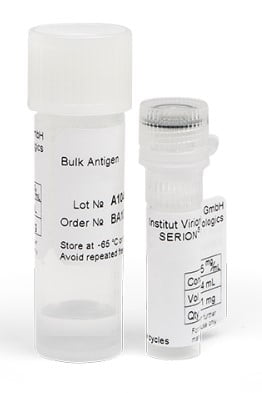| Weight | 1 lbs |
|---|---|
| Dimensions | 9 × 5 × 2 in |
| host | mouse |
| isotype | IgG1 |
| clonality | monoclonal |
| concentration | 1 mg/mL |
| applications | ICC/IF, WB |
| reactivity | Insulin |
| available sizes | 200 µg |
mouse anti-Insulin monoclonal antibody (7F8) 5262
$364.00
Antibody summary
- Mouse monoclonal to Insulin
- Suitable for: ELISA
- Isotype: IgG1
- 200 µg
mouse anti-Insulin monoclonal antibody (7F8) 5262
| antibody |
|---|
| Tested applications ELISA |
| Immunogen Purified human insulin |
| Size and concentration 200µg and lot specific |
| Form liquid |
| Storage Instructions These antibodies are stable for at least one (1) year at -20°C to -70°C. May also be stored at 4°C. |
| Storage buffer PBS, pH 7.4, 0.09% NaN3. |
| Purity protein affinity purification |
| Clonality monoclonal |
| Isotype IgG1 |
| Compatible secondaries goat anti-mouse IgG, H&L chain specific, peroxidase conjugated polyclonal antibody 5486 goat anti-mouse IgG, H&L chain specific, biotin conjugated, Conjugate polyclonal antibody 2685 goat anti-mouse IgG, H&L chain specific, FITC conjugated polyclonal antibody 7854 goat anti-mouse IgG, H&L chain specific, peroxidase conjugated polyclonal antibody, crossabsorbed 1706 goat anti-mouse IgG, H&L chain specific, biotin conjugated polyclonal antibody, crossabsorbed 1716 goat anti-mouse IgG, H&L chain specific, FITC conjugated polyclonal antibody, crossabsorbed 1721 |
| Isotype control Mouse monocolonal IgG1 - Isotype Control |
| target relevance |
|---|
| Protein names Insulin [Cleaved into: Insulin B chain; Insulin A chain] |
| Gene names INS,INS |
| Protein family Insulin family |
| Mass 11981Da |
| Function FUNCTION: Insulin decreases blood glucose concentration. It increases cell permeability to monosaccharides, amino acids and fatty acids. It accelerates glycolysis, the pentose phosphate cycle, and glycogen synthesis in liver. |
| Subellular location SUBCELLULAR LOCATION: Secreted. |
| Structure SUBUNIT: Heterodimer of a B chain and an A chain linked by two disulfide bonds (PubMed:25423173). {ECO:0000269|PubMed:25423173}. |
| Involvement in disease DISEASE: Hyperproinsulinemia (HPRI) [MIM:616214]: An autosomal dominant condition characterized by elevated levels of serum proinsulin-like material. {ECO:0000269|PubMed:1601997, ECO:0000269|PubMed:2196279, ECO:0000269|PubMed:3470784, ECO:0000269|PubMed:4019786, ECO:0000269|PubMed:6312455, ECO:0000269|PubMed:6424111, ECO:0000269|PubMed:8421693}. Note=The disease is caused by variants affecting the gene represented in this entry.; DISEASE: Type 1 diabetes mellitus 2 (T1D2) [MIM:125852]: A multifactorial disorder of glucose homeostasis that is characterized by susceptibility to ketoacidosis in the absence of insulin therapy. Clinical features are polydipsia, polyphagia and polyuria which result from hyperglycemia-induced osmotic diuresis and secondary thirst. These derangements result in long-term complications that affect the eyes, kidneys, nerves, and blood vessels. {ECO:0000269|PubMed:18192540}. Note=The disease is caused by variants affecting the gene represented in this entry.; DISEASE: Diabetes mellitus, permanent neonatal, 4 (PNDM4) [MIM:618858]: A form of permanent neonatal diabetes mellitus, a type of diabetes characterized by onset of persistent hyperglycemia within the first six months of life. Initial clinical manifestations include intrauterine growth retardation, hyperglycemia, glycosuria, osmotic polyuria, severe dehydration, and failure to thrive. PNDM4 transmission pattern is consistent with autosomal dominant or autosomal recessive inheritance. {ECO:0000269|PubMed:17855560, ECO:0000269|PubMed:18162506}. Note=The disease is caused by variants affecting the gene represented in this entry.; DISEASE: Maturity-onset diabetes of the young 10 (MODY10) [MIM:613370]: A form of diabetes that is characterized by an autosomal dominant mode of inheritance, onset in childhood or early adulthood (usually before 25 years of age), a primary defect in insulin secretion and frequent insulin-independence at the beginning of the disease. {ECO:0000269|PubMed:18162506, ECO:0000269|PubMed:18192540, ECO:0000269|PubMed:20226046, ECO:0000269|PubMed:25423173}. Note=The disease is caused by variants affecting the gene represented in this entry. |
| Target Relevance information above includes information from UniProt accession: P01308 |
| The UniProt Consortium |
Data
| No results found |
Publications
| pmid | title | authors | citation |
|---|---|---|---|
| We haven't added any publications to our database yet. | |||
Protocols
| relevant to this product |
|---|
| ELISA |
Documents
| # | SDS | Certificate | |
|---|---|---|---|
| Please enter your product and batch number here to retrieve product datasheet, SDS, and QC information. | |||
Only logged in customers who have purchased this product may leave a review.








Reviews
There are no reviews yet.